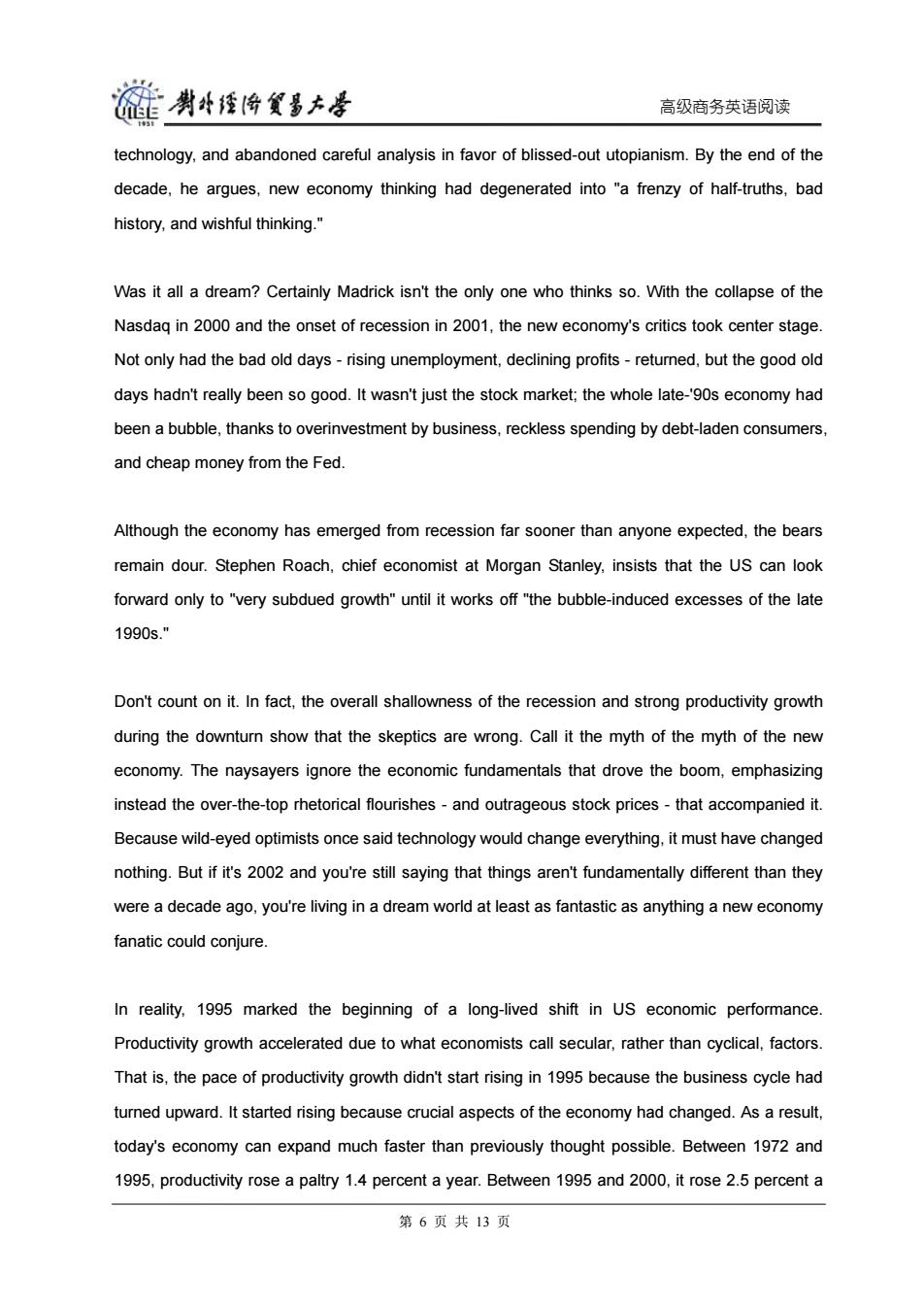正在加载图片...

碰剥经悔贸墨大号 高级商务英语阅读 technology,and abandoned careful analysis in favor of blissed-out utopianism.By the end of the decade,he argues,new economy thinking had degenerated into "a frenzy of half-truths,bad history,and wishful thinking." Was it all a dream?Certainly Madrick isn't the only one who thinks so.With the collapse of the Nasdaq in 2000 and the onset of recession in 2001,the new economy's critics took center stage. Not only had the bad old days-rising unemployment,declining profits-returned,but the good old days hadn't really been so good.It wasn't just the stock market;the whole late-'90s economy had been a bubble,thanks to overinvestment by business,reckless spending by debt-laden consumers, and cheap money from the Fed. Although the economy has emerged from recession far sooner than anyone expected,the bears remain dour.Stephen Roach,chief economist at Morgan Stanley,insists that the US can look forward only to "very subdued growth"until it works off "the bubble-induced excesses of the late 1990s." Don't count on it.In fact,the overall shallowness of the recession and strong productivity growth during the downturn show that the skeptics are wrong.Call it the myth of the myth of the new economy.The naysayers ignore the economic fundamentals that drove the boom,emphasizing instead the over-the-top rhetorical flourishes-and outrageous stock prices-that accompanied it. Because wild-eyed optimists once said technology would change everything,it must have changed nothing.But if it's 2002 and you're still saying that things aren't fundamentally different than they were a decade ago,you're living in a dream world at least as fantastic as anything a new economy fanatic could conjure. In reality,1995 marked the beginning of a long-lived shift in US economic performance. Productivity growth accelerated due to what economists call secular,rather than cyclical,factors. That is,the pace of productivity growth didn't start rising in 1995 because the business cycle had turned upward.It started rising because crucial aspects of the economy had changed.As a result. today's economy can expand much faster than previously thought possible.Between 1972 and 1995,productivity rose a paltry 1.4 percent a year.Between 1995 and 2000,it rose 2.5 percent a 第6页共13页高级商务英语阅读 technology, and abandoned careful analysis in favor of blissed-out utopianism. By the end of the decade, he argues, new economy thinking had degenerated into "a frenzy of half-truths, bad history, and wishful thinking." Was it all a dream? Certainly Madrick isn't the only one who thinks so. With the collapse of the Nasdaq in 2000 and the onset of recession in 2001, the new economy's critics took center stage. Not only had the bad old days - rising unemployment, declining profits - returned, but the good old days hadn't really been so good. It wasn't just the stock market; the whole late-'90s economy had been a bubble, thanks to overinvestment by business, reckless spending by debt-laden consumers, and cheap money from the Fed. Although the economy has emerged from recession far sooner than anyone expected, the bears remain dour. Stephen Roach, chief economist at Morgan Stanley, insists that the US can look forward only to "very subdued growth" until it works off "the bubble-induced excesses of the late 1990s." Don't count on it. In fact, the overall shallowness of the recession and strong productivity growth during the downturn show that the skeptics are wrong. Call it the myth of the myth of the new economy. The naysayers ignore the economic fundamentals that drove the boom, emphasizing instead the over-the-top rhetorical flourishes - and outrageous stock prices - that accompanied it. Because wild-eyed optimists once said technology would change everything, it must have changed nothing. But if it's 2002 and you're still saying that things aren't fundamentally different than they were a decade ago, you're living in a dream world at least as fantastic as anything a new economy fanatic could conjure. In reality, 1995 marked the beginning of a long-lived shift in US economic performance. Productivity growth accelerated due to what economists call secular, rather than cyclical, factors. That is, the pace of productivity growth didn't start rising in 1995 because the business cycle had turned upward. It started rising because crucial aspects of the economy had changed. As a result, today's economy can expand much faster than previously thought possible. Between 1972 and 1995, productivity rose a paltry 1.4 percent a year. Between 1995 and 2000, it rose 2.5 percent a 第 6 页 共 13 页